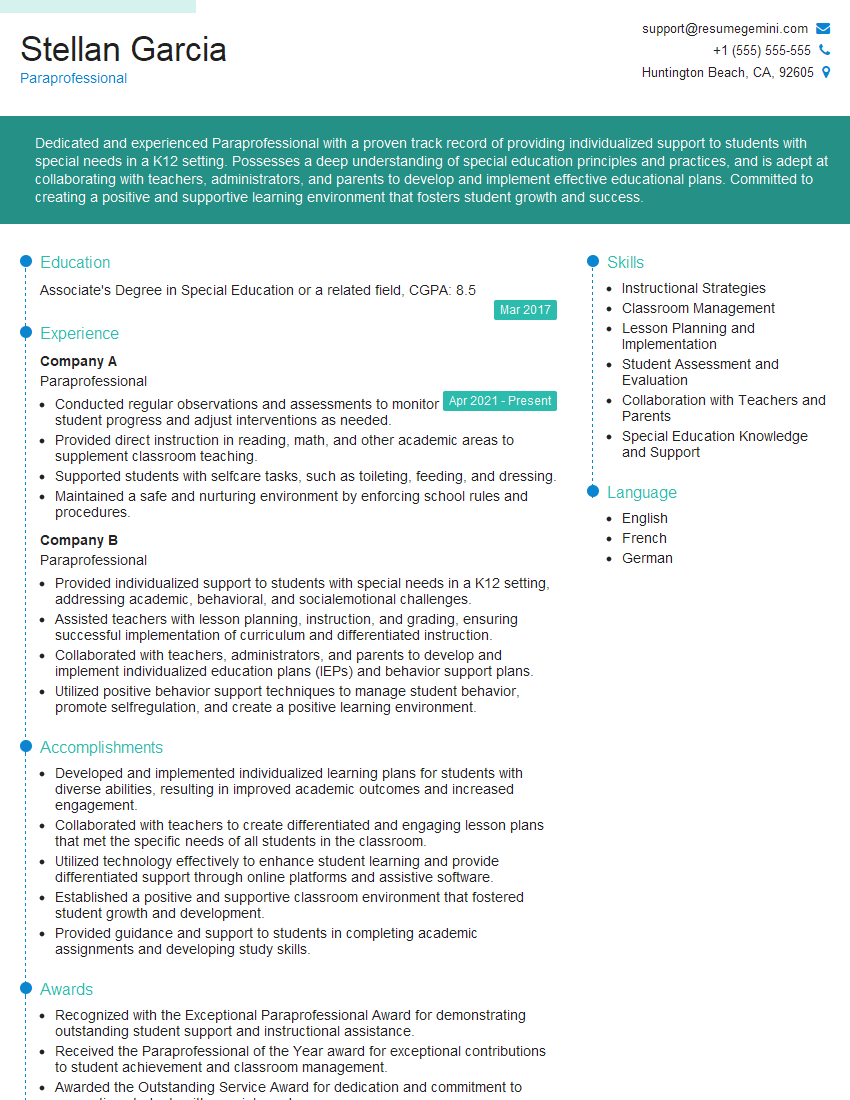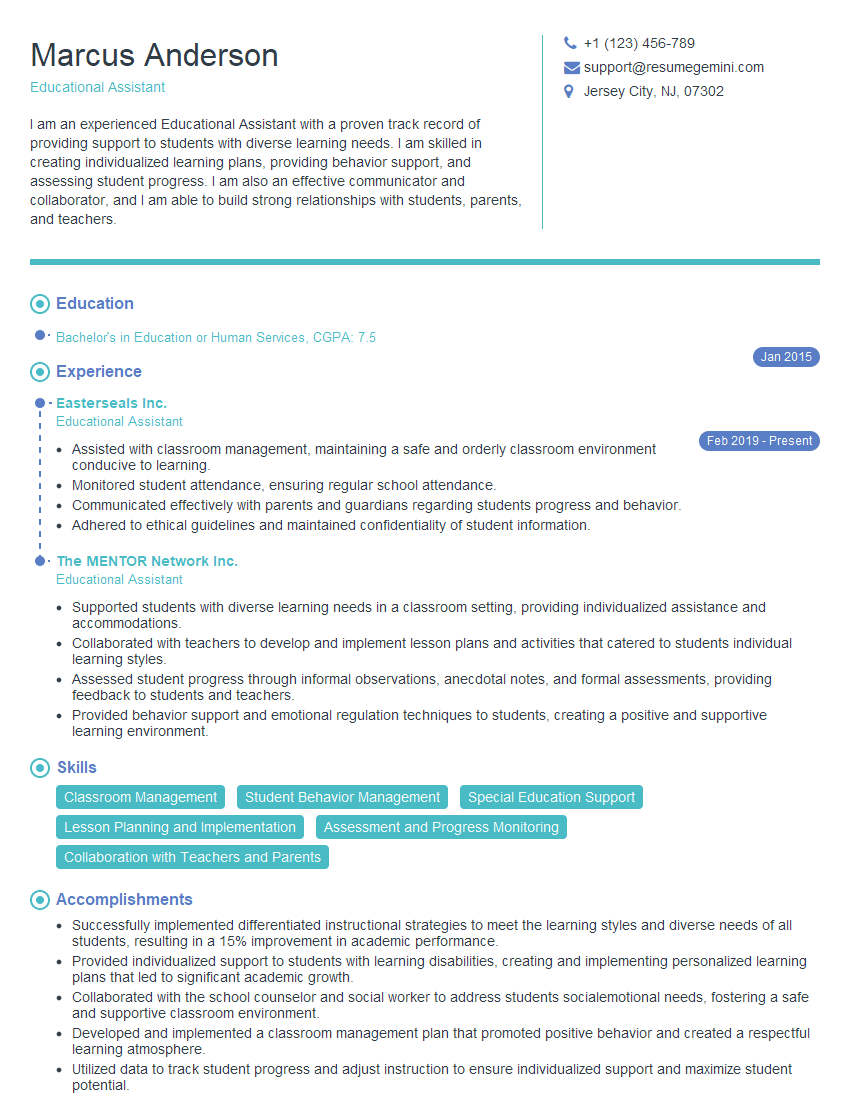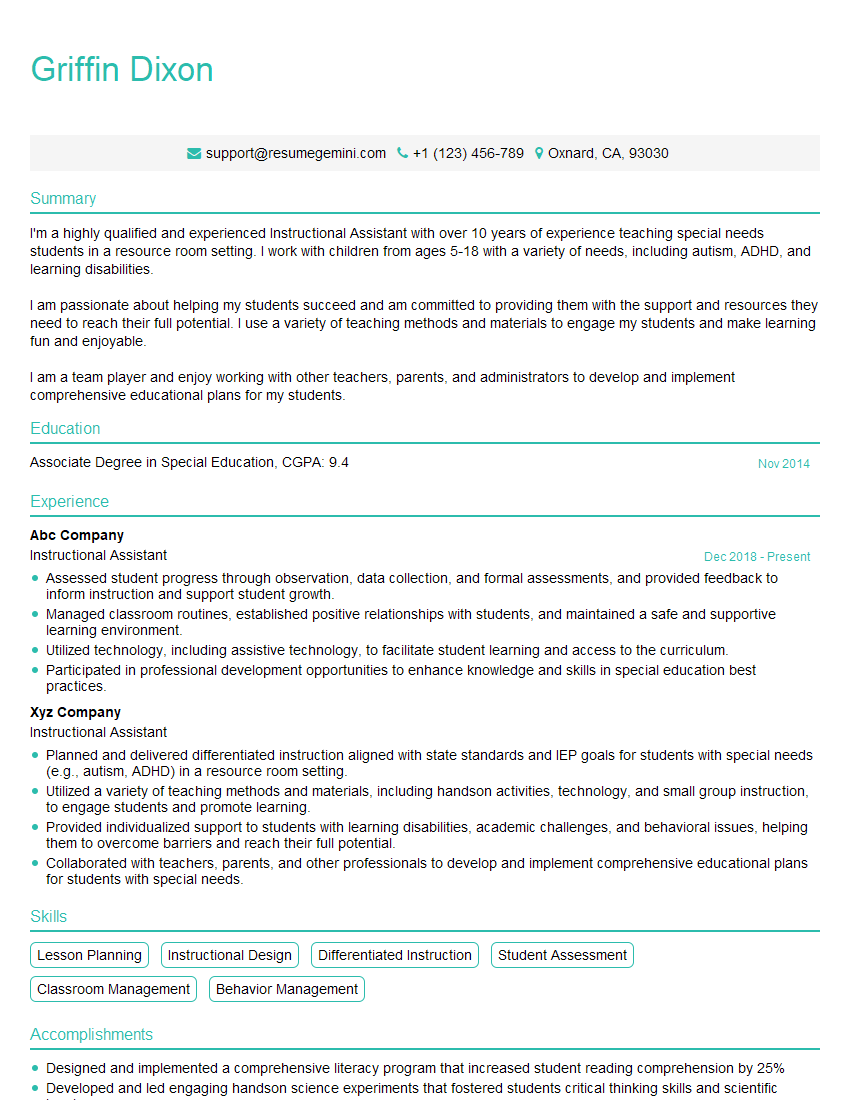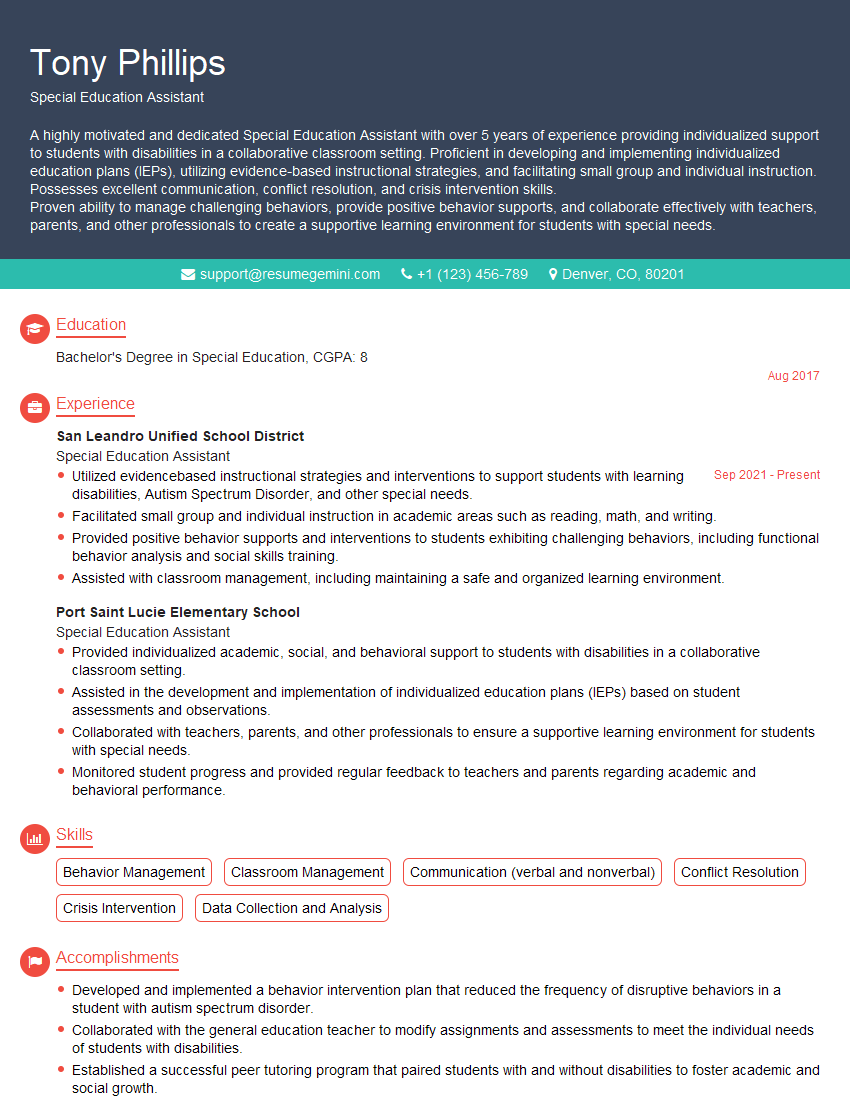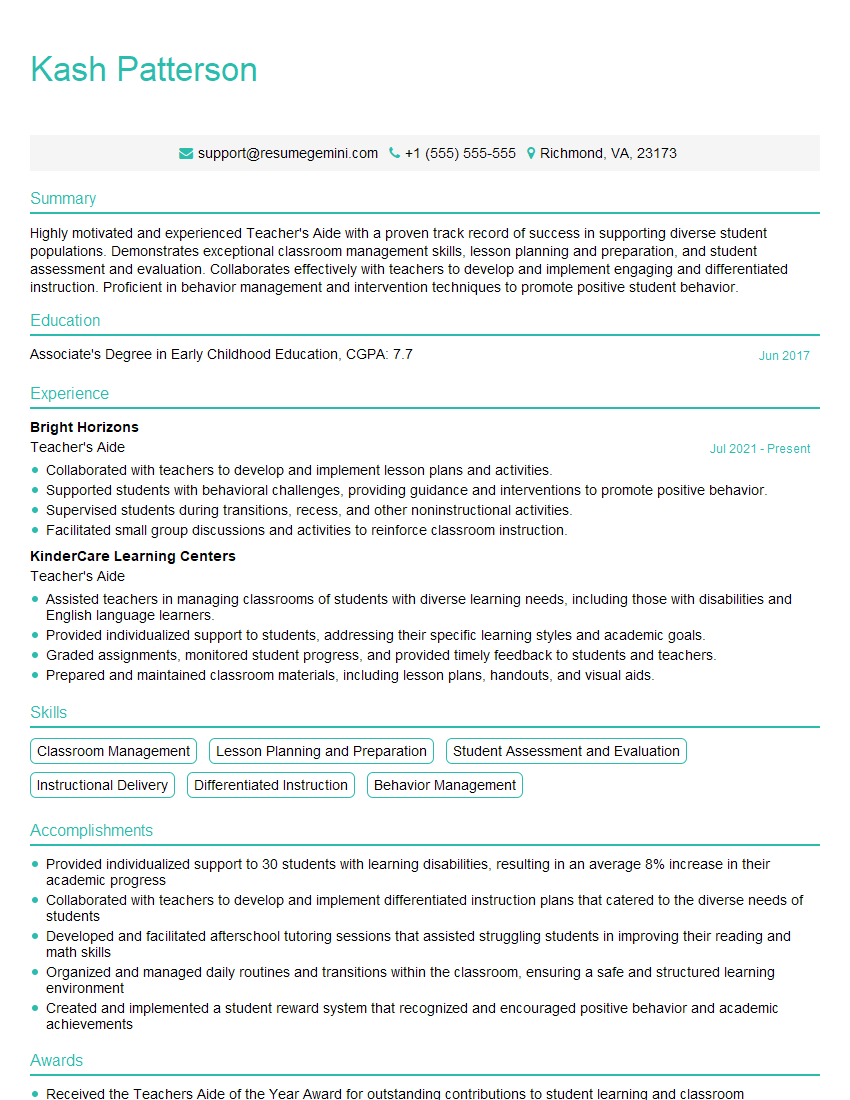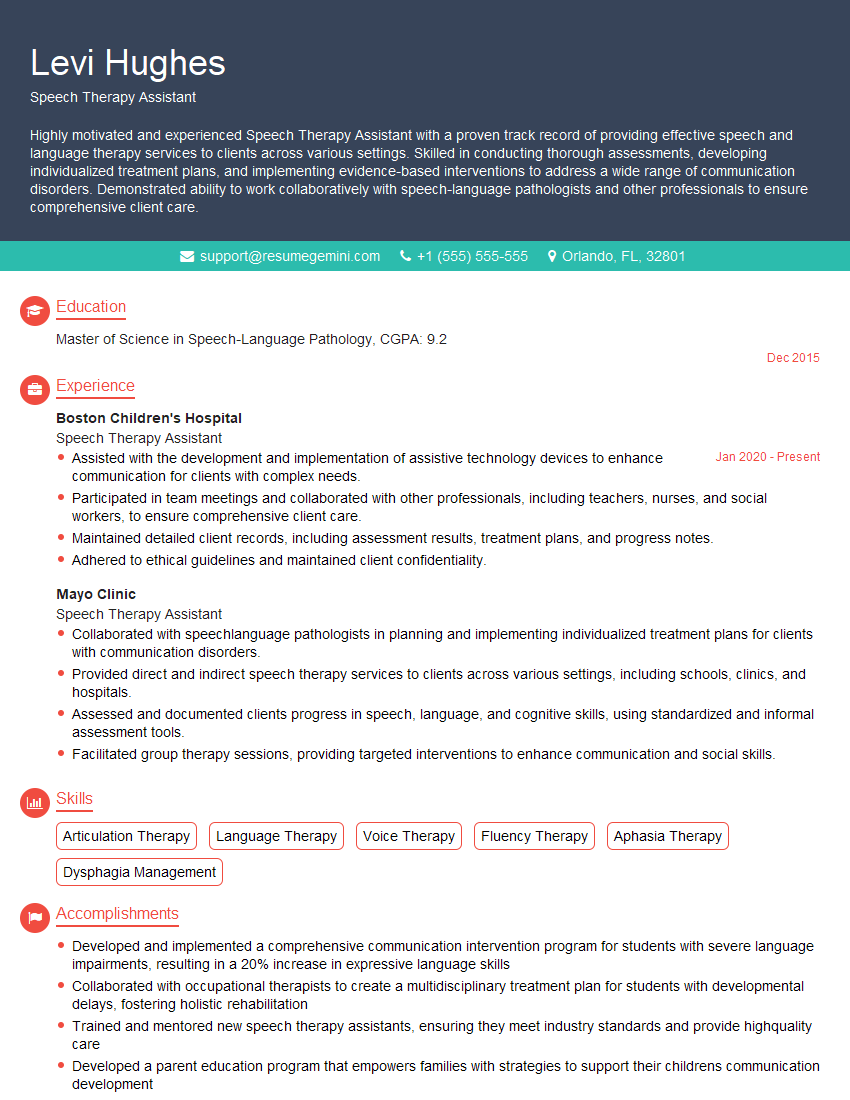Interviews are more than just a Q&A session—they’re a chance to prove your worth. This blog dives into essential Educational Assistant interview questions and expert tips to help you align your answers with what hiring managers are looking for. Start preparing to shine!
Questions Asked in Educational Assistant Interview
Q 1. Describe your experience working with students with IEPs or 504 plans.
Throughout my five years as an Educational Assistant, I’ve extensively worked with students possessing Individualized Education Programs (IEPs) and 504 plans. I understand that these plans are crucial for tailoring education to meet individual needs. An IEP is a legally binding document outlining specific learning goals and support services for students with disabilities, while a 504 plan addresses the needs of students with disabilities that don’t meet the criteria for an IEP but still require accommodations to succeed in the regular classroom.
For instance, I’ve assisted students with IEPs requiring one-on-one support in reading comprehension. This involved employing differentiated instruction techniques, breaking down complex texts into smaller chunks, and using visual aids to enhance understanding. With students under 504 plans, I’ve often provided extra time for assessments, preferential seating arrangements, and organized their materials to minimize distractions. In both cases, I prioritize regular communication with the special education teacher and classroom teacher to ensure the student’s progress aligns with their plan’s goals and that my support is effective and consistent.
Q 2. How do you differentiate instruction to meet diverse learning needs?
Differentiating instruction is key to catering to the diverse learning styles and needs within a classroom. It’s about providing varied learning opportunities and materials to ensure every student can access and understand the curriculum. My approach involves a three-pronged strategy:
- Assessing Learning Styles: I begin by observing students to identify their preferred learning methods (visual, auditory, kinesthetic). For example, some students thrive with visual aids like diagrams and flashcards, while others benefit from auditory learning, like listening to audiobooks or engaging in discussions.
- Adapting Materials: Once learning styles are identified, I adapt materials accordingly. This might involve providing graphic organizers for note-taking, creating alternative assignments that focus on different skillsets, or using assistive technology like text-to-speech software.
- Providing Varied Activities: I incorporate a range of activities into lessons, including group work, independent projects, games, and hands-on experiments. This allows students to demonstrate their understanding in ways that suit their strengths. For instance, a student who struggles with written assignments might excel in an oral presentation.
This multifaceted approach ensures every student has the chance to learn and succeed, regardless of their learning style or pace.
Q 3. Explain your experience with behavior management techniques.
Effective behavior management is crucial for creating a positive and productive learning environment. My approach is proactive and positive, focusing on preventing disruptive behaviors before they occur. I employ a variety of strategies, including:
- Positive Reinforcement: I consistently praise and reward positive behaviors, using verbal encouragement, stickers, or small privileges. This helps reinforce desired actions.
- Clear Expectations: I ensure students understand classroom rules and expectations from the beginning, clearly communicating consequences for rule violations. I present these rules in simple, understandable terms, sometimes using visuals.
- Proximity Control: Sometimes, simply moving closer to a student who is starting to become disruptive can prevent the behavior from escalating. A non-verbal cue is often effective.
- Redirection: When a student is off-task, I gently redirect their attention back to the activity. A simple prompt like, “Let’s get back to working on our math problems,” can be effective.
- Collaboration with Teachers and Parents: I work closely with teachers and parents to create a consistent approach to behavior management both at school and at home.
It’s important to remember that each student is different, and what works for one might not work for another. Adaptability and flexibility are essential in behavior management.
Q 4. How do you build positive relationships with students and their families?
Building strong relationships with students and their families is fundamental to my role as an Educational Assistant. Open communication and trust are key. With students, I create a safe and supportive environment where they feel comfortable asking questions and sharing their concerns. I show genuine interest in their lives and accomplishments, both inside and outside of the classroom. Simple gestures, like remembering their favorite activities or offering a kind word, go a long way.
Regarding families, I maintain regular communication through emails, phone calls, and parent-teacher conferences. I share updates on the student’s progress, highlight their achievements, and discuss any challenges or concerns. I approach these conversations with empathy and a focus on collaboration, aiming to create a partnership where we’re working together to support the student’s success.
For example, I once organized a classroom “family night” where parents could participate in activities with their children. This created a relaxed and informal setting to build connections between families and the school.
Q 5. Describe a time you had to adapt your approach to a challenging student.
I once worked with a student who consistently displayed disruptive behavior, frequently interrupting class and refusing to participate in activities. My initial approach, which focused primarily on redirection and positive reinforcement, proved ineffective. I realized I needed to adapt my strategy.
After consulting with the teacher and special education staff, we developed a new plan that incorporated elements of positive behavior support and functional behavioral assessment. We carefully observed the student’s behavior to identify its triggers and underlying causes. We discovered that the student’s disruptive behavior often stemmed from feelings of frustration and anxiety related to academic tasks.
We then introduced a system of visual cues and task-breaking strategies to help the student manage their workload and reduce their frustration. We also implemented a reward system that focused on effort rather than just outcome. By showing genuine understanding and tailoring my support to their specific needs, I witnessed a significant improvement in the student’s behavior and academic performance.
Q 6. What strategies do you use to support students’ social-emotional learning?
Supporting students’ social-emotional learning (SEL) is integral to their overall well-being and academic success. I incorporate various strategies to foster SEL, including:
- Mindfulness Activities: I introduce short mindfulness exercises, such as deep breathing or guided meditation, to help students manage stress and anxiety.
- Social Skills Groups: I facilitate small group activities that focus on developing essential social skills, such as active listening, empathy, and conflict resolution.
- Emotional Check-ins: At the start of the day or during transitions, I create opportunities for students to share their feelings and discuss any challenges they may be facing. This helps them feel heard and supported.
- Role-Playing: I use role-playing scenarios to help students practice appropriate social behaviors and navigate challenging social situations.
- Collaborative Projects: Group projects encourage teamwork, communication, and cooperation, helping students learn to work effectively with others.
By prioritizing SEL, I contribute to creating a classroom where students feel safe, respected, and supported in their emotional development.
Q 7. How familiar are you with assistive technology and adaptive equipment?
I have a working knowledge of various assistive technologies and adaptive equipment. My experience includes assisting students with:
- Text-to-speech software: I’ve helped students utilize programs like NaturalReader and Read&Write Gold to access written materials, improving their reading comprehension and independence.
- Augmentative and alternative communication (AAC) devices: I’ve supported students who use picture exchange systems (PECS) or speech-generating devices to communicate their needs and ideas.
- Adaptive writing tools: I’m familiar with ergonomic writing tools, such as pencil grips and slant boards, that improve writing comfort and accuracy.
- Adaptive computer equipment: My experience extends to using specialized keyboards, trackballs, and other input devices to help students interact more easily with computers.
While I am not a certified Assistive Technology specialist, I am adept at utilizing these tools to support student learning and am always eager to learn more about emerging technologies in this field. I collaborate closely with the school’s Assistive Technology specialist to ensure that students receive the most appropriate and effective support.
Q 8. How do you collaborate effectively with teachers and other staff members?
Effective collaboration with teachers and staff is the cornerstone of a successful educational environment. It involves proactive communication, active listening, and a shared commitment to student success. I believe in establishing strong working relationships built on mutual respect and trust.
- Proactive Communication: I regularly check in with teachers to discuss student progress, identify challenges, and plan interventions. I proactively share observations and insights, rather than waiting to be asked.
- Active Listening: I listen attentively to teachers’ concerns and suggestions, seeking to understand their perspectives before offering solutions. This ensures that my support aligns with the teacher’s overall classroom management and instructional strategies.
- Shared Goal Setting: I participate in team meetings and contribute to the development of Individualized Education Programs (IEPs) and 504 plans, ensuring alignment of support strategies with the student’s educational goals.
- Example: In my previous role, I worked closely with a special education teacher to develop a modified assignment for a student with dyslexia. By collaborating and actively listening to her concerns, we created a task that both challenged the student and ensured success.
Q 9. Describe your experience with data collection and progress monitoring.
Data collection and progress monitoring are crucial for evaluating student learning and making data-driven decisions to improve instruction. I am proficient in various methods for collecting data, including both quantitative and qualitative measures.
- Quantitative Data: This involves using standardized assessments, quizzes, and tests to track student progress on specific skills and objectives. I am skilled in using data management systems to track this information and generate reports. I use this data to identify trends and inform interventions.
- Qualitative Data: This includes anecdotal notes, observations of student behavior and engagement, and work samples. I use qualitative data to gain a holistic understanding of a student’s learning needs and challenges. Qualitative data can provide valuable context that is missed by solely focusing on quantitative data.
- Progress Monitoring: I regularly monitor student progress, comparing their performance against baseline data and individualized goals. I use this data to inform adjustments to instructional strategies and interventions.
- Example: In one instance, while monitoring a student’s progress in reading fluency, I noticed a plateau in their performance using quantitative data. By observing their reading (qualitative data), I discovered a frustration with a particular type of text, which lead to the implementation of a more supportive strategy, helping them overcome the plateau.
Q 10. How do you maintain confidentiality and adhere to ethical guidelines?
Maintaining confidentiality and adhering to ethical guidelines is paramount in my work. I understand the importance of protecting student privacy and maintaining professional boundaries. My practice adheres strictly to FERPA (Family Educational Rights and Privacy Act) guidelines and school policies.
- Confidentiality: I only share student information with authorized personnel on a need-to-know basis, never discussing student matters with individuals not directly involved in their education. I securely store all student records and data.
- Professional Boundaries: I maintain appropriate professional relationships with students and their families, avoiding personal interactions outside of the school setting. I avoid sharing personal information about myself with students.
- Ethical Decision-Making: I am committed to making ethical decisions that prioritize student well-being and learning. I always report any concerns about child safety or abuse, following established school protocol.
- Example: If I overheard a student discussing a personal issue, I would address it sensitively, ensuring their privacy while guiding them towards appropriate support channels if needed.
Q 11. Explain your understanding of different learning styles and disabilities.
Understanding diverse learning styles and disabilities is critical for providing effective support to all students. My approach is individualized and focuses on creating a learning environment that caters to each student’s unique needs.
- Learning Styles: I am familiar with various learning styles, including visual, auditory, kinesthetic, and reading/writing preferences. I adapt my teaching strategies to accommodate different learning preferences, using a variety of instructional methods and materials.
- Disabilities: I have experience supporting students with various learning disabilities, such as dyslexia, ADHD, autism spectrum disorder, and intellectual disabilities. I understand the accommodations and modifications necessary to help these students succeed.
- Individualized Approach: I work closely with teachers and specialists to create individualized learning plans for students with disabilities, ensuring that their needs are met. I also adapt teaching materials and techniques according to these plans.
- Example: I have supported students with dyslexia by utilizing multisensory teaching methods, providing extra time for assignments, and using assistive technology such as text-to-speech software.
Q 12. How do you promote a positive and inclusive classroom environment?
Creating a positive and inclusive classroom environment is essential for student learning and well-being. My strategies focus on building positive relationships, fostering a sense of belonging, and promoting respect among students.
- Positive Relationships: I build positive relationships with students by showing genuine care and concern for their well-being. I use positive reinforcement and celebrate their achievements.
- Sense of Belonging: I create a classroom where every student feels valued and respected, regardless of their background, abilities, or learning style. I actively promote diversity and inclusion.
- Respectful Interactions: I establish clear expectations for respectful behavior and actively model this behavior in all interactions. I address any instances of bullying or harassment immediately and decisively.
- Example: I use class meetings to foster open communication, encourage students to share their feelings and experiences, and solve problems together democratically.
Q 13. Describe your experience working with students from diverse backgrounds.
Working with students from diverse backgrounds has enriched my experience immensely. I believe in creating a classroom that celebrates cultural differences and promotes understanding among students.
- Cultural Awareness: I am mindful of cultural differences in communication styles, learning preferences, and family values. I strive to create a classroom environment that respects and acknowledges these differences.
- Inclusive Curriculum: I support the use of inclusive curricula that reflect the diversity of the student population. I actively seek out diverse literature, materials, and activities.
- Family Engagement: I actively engage with families from diverse backgrounds, respecting and valuing their perspectives and input on their child’s education.
- Example: I have incorporated multicultural literature and activities into my lesson plans to better represent the diverse backgrounds of the students in my classroom and foster cross-cultural understanding.
Q 14. How do you handle conflict resolution among students?
Conflict resolution is an important skill for creating a positive classroom environment. My approach is proactive, focusing on teaching conflict resolution strategies and addressing conflicts fairly and effectively.
- Proactive Strategies: I establish clear classroom rules and expectations, encouraging students to communicate respectfully and resolve their own conflicts.
- Mediation: When conflicts arise, I mediate discussions, helping students understand each other’s perspectives and find mutually acceptable solutions. I help them to brainstorm solutions together.
- Restorative Justice: I use restorative justice practices to address harmful behaviors, focusing on repairing harm and restoring relationships.
- Example: If two students are arguing, I will guide them through a structured conversation, asking them to express their perspectives and then collaboratively finding a solution that satisfies both. This teaches them valuable conflict-resolution skills.
Q 15. What are your strengths and weaknesses as an Educational Assistant?
My greatest strengths as an Educational Assistant lie in my patience, empathy, and ability to build rapport with students of diverse learning styles and needs. I’m highly organized and proactive, anticipating challenges and developing solutions before they become major issues. I excel at differentiating instruction, adapting materials to meet individual student requirements, and providing positive reinforcement. For example, I once worked with a student struggling with reading comprehension. By breaking down complex texts into smaller chunks and using visual aids, I helped him significantly improve his understanding. My weakness? I sometimes take on too much, striving for perfection. I’m actively working on delegating tasks appropriately and setting realistic boundaries to manage my workload effectively.
Career Expert Tips:
- Ace those interviews! Prepare effectively by reviewing the Top 50 Most Common Interview Questions on ResumeGemini.
- Navigate your job search with confidence! Explore a wide range of Career Tips on ResumeGemini. Learn about common challenges and recommendations to overcome them.
- Craft the perfect resume! Master the Art of Resume Writing with ResumeGemini’s guide. Showcase your unique qualifications and achievements effectively.
- Don’t miss out on holiday savings! Build your dream resume with ResumeGemini’s ATS optimized templates.
Q 16. How do you prioritize tasks and manage your time effectively?
Prioritizing tasks and managing my time effectively involves a multi-pronged approach. First, I create a daily to-do list, prioritizing tasks based on urgency and importance using the Eisenhower Matrix (Urgent/Important). This helps me focus on what truly matters. Second, I break down large tasks into smaller, manageable steps. This prevents feeling overwhelmed and makes progress more visible. For instance, if I need to prepare materials for a science experiment, I’ll break it down into steps like gathering supplies, prepping the workspace, creating instructions, and organizing student groups. Finally, I utilize time-blocking techniques, scheduling specific time slots for different activities, building in buffer time for unexpected events, and sticking to the schedule as much as possible. This structured approach ensures I remain productive and meet deadlines consistently.
Q 17. Describe your experience with classroom management strategies.
Classroom management is crucial for a positive learning environment. My strategies focus on creating clear expectations and routines from the start. I believe in positive reinforcement, rewarding good behavior and effort, rather than solely focusing on punishment. I use proactive strategies, such as establishing clear visual cues for transitions between activities and employing preventative measures to address potential disruptive behaviors before they escalate. For example, I might engage students individually who seem restless, providing them with a small task or check-in to keep them focused. If a behavior issue arises, I calmly address it privately, working with the student to understand the underlying reason and develop appropriate solutions. Collaboration with the teacher is paramount, ensuring consistency and supporting the classroom’s overall behavioral framework.
Q 18. How do you ensure student safety and well-being?
Ensuring student safety and well-being is my top priority. This involves constant vigilance, observing students for any signs of distress or potential harm. I am trained in emergency procedures and CPR, ready to respond effectively in case of an accident. I consistently maintain a safe and organized learning environment, ensuring pathways are clear, materials are stored appropriately, and potential hazards are eliminated. I communicate openly with the teacher and school staff regarding any concerns, reporting any incidents immediately. Building trusting relationships with students is key, creating a safe space where they feel comfortable sharing their concerns without fear of judgment. Promoting emotional wellbeing through positive interactions, empathy, and active listening are crucial elements in my approach.
Q 19. What are your expectations for professional development as an Educational Assistant?
My expectations for professional development are high. I am eager to continuously expand my knowledge and skills to best support students. I’m particularly interested in workshops focusing on inclusive practices, assistive technology, and strategies for working with students with diverse learning needs. Opportunities to collaborate with other educational professionals and share best practices are invaluable. I’m also keen to learn more about trauma-informed practices and strategies for creating a supportive and nurturing classroom environment for all learners. Staying current with research-based practices and new teaching methodologies is essential to remain effective and provide high-quality support.
Q 20. How do you support students with specific learning challenges (e.g., dyslexia, ADHD)?
Supporting students with specific learning challenges requires a tailored approach. For students with dyslexia, I utilize multi-sensory teaching methods, incorporating visual, auditory, and kinesthetic learning strategies. I may use assistive technologies, such as text-to-speech software and graphic organizers, to enhance comprehension and reduce reading difficulties. With students with ADHD, I focus on creating a structured and organized learning environment, breaking down tasks into smaller, manageable steps, and providing frequent positive feedback and encouragement. I incorporate movement breaks and utilize strategies to improve focus and attention. Collaboration with the student’s special education teacher is critical to developing an Individualized Education Program (IEP) and implementing effective interventions. Each student’s needs are unique, and I strive to create a personalized support plan.
Q 21. How familiar are you with the school’s discipline policy?
I am thoroughly familiar with the school’s discipline policy. I understand the procedures for reporting incidents, addressing behavioral issues, and collaborating with the school administration and staff to ensure consistent enforcement. I am aware of the school’s expectations regarding student conduct and the consequences for violating the policy. I believe in adhering to the established procedures and ensuring that all disciplinary actions are implemented fairly and consistently. My understanding of the policy enables me to provide effective support to students and contribute to a safe and orderly learning environment. I also know the process for escalating incidents to appropriate personnel and the protocols for dealing with severe infractions.
Q 22. How do you communicate effectively with students who have communication difficulties?
Effective communication with students facing communication difficulties requires patience, understanding, and a multi-faceted approach. I adapt my communication style to suit the individual student’s needs. This might involve using visual aids like pictures or symbols, employing simpler language, giving clear and concise instructions, breaking down complex tasks into smaller, manageable steps, and allowing ample time for responses. I also utilize augmentative and alternative communication (AAC) methods, such as picture exchange systems (PECS) or communication boards, when appropriate. For students with auditory processing challenges, I ensure clear visual cues and reduce background noise. For students with speech impediments, I provide opportunities for them to communicate non-verbally if needed and listen patiently to their attempts at verbal communication, offering positive reinforcement for their efforts.
For example, when working with a student who struggles with expressive language, I might use a visual schedule to show them the day’s activities. If a student has difficulty understanding verbal instructions, I’d demonstrate the task first and then offer simple, step-by-step instructions with visual aids. Consistent positive reinforcement and celebrating small successes are crucial to build confidence and encourage communication.
Q 23. How do you maintain accurate records and documentation?
Maintaining accurate records and documentation is paramount for effective educational support. I utilize a combination of electronic and paper-based systems, depending on the school’s requirements and the student’s needs. This includes detailed anecdotal notes documenting student behavior, progress, and challenges observed during classroom activities, interventions, and individual support sessions. I meticulously record IEP (Individualized Education Program) goals and objectives, tracking student progress towards those goals with quantifiable data, such as test scores or observation checklists. All information is date-stamped and securely stored, adhering to all relevant privacy regulations (FERPA).
For example, I might use a digital platform to maintain a comprehensive record of a student’s progress on their IEP goals. Each data entry includes the date, specific activity, student performance, and any relevant observations. This allows for easy access to this critical information for both the teacher and other educational professionals.
Q 24. Describe your experience with supporting students during testing.
My experience supporting students during testing involves understanding and implementing their individualized accommodations as outlined in their IEP or 504 plan. This could include providing extended time, preferential seating, allowing the use of assistive technology, reading test items aloud, or providing alternative response formats. I ensure a calm and distraction-free testing environment, and I remain attentive to the student’s needs throughout the testing period, offering encouragement and support without providing assistance that violates testing protocols. My role is to create an environment where students can demonstrate their understanding without unnecessary barriers.
For instance, I assisted a student with dyslexia during standardized testing by providing him with a text-to-speech software and extra time. I also ensured that the testing environment was quiet and distraction-free, allowing him to focus on his work.
Q 25. How would you handle a situation where a student is exhibiting disruptive behavior?
Handling disruptive behavior requires a calm and proactive approach. My first step is to identify the underlying cause of the disruption. Is the student tired, hungry, overwhelmed, or feeling frustrated? Once the cause is understood, I employ appropriate strategies to address the behavior. This might involve redirecting the student’s attention, providing positive reinforcement for appropriate behavior, implementing pre-planned strategies as outlined in the student’s behavioral support plan (BSP), or contacting the teacher to collaborate on a solution. In more serious situations, I may need to intervene to ensure the safety of the student and others, while documenting the incident thoroughly.
For example, if a student is exhibiting disruptive behavior because they are overwhelmed by a task, I might break the task into smaller, more manageable steps or offer them a short break. If a student is disrupting class due to a lack of engagement, I might work with them to find ways to make the material more relatable or involve them in a more active learning approach.
Q 26. What are your strategies for supporting students’ participation in classroom activities?
Supporting student participation in classroom activities involves creating an inclusive and encouraging environment. I modify activities as needed to ensure accessibility for all students, including those with physical, cognitive, or learning disabilities. This may involve adapting materials, providing assistive technology, offering peer support, or breaking down complex tasks into smaller, manageable steps. I encourage active participation by providing positive reinforcement, celebrating successes, and providing individualized assistance when needed. I also actively foster a sense of belonging and community within the classroom.
For instance, I might pair a student who struggles with writing with a peer who excels at it during group projects. Or, I might provide a student with a visual aid to help them understand the instructions for a group activity.
Q 27. How would you respond to a student who is experiencing emotional distress?
Responding to a student experiencing emotional distress requires empathy, understanding, and a calm demeanor. My first priority is to ensure the student’s safety and well-being. I create a safe and supportive environment where the student feels comfortable expressing their emotions. I use active listening skills to understand the student’s concerns without judgment. I may offer comforting words, reassurance, and emotional support. Depending on the severity of the distress, I might refer the student to the school counselor or other appropriate support personnel. Maintaining confidentiality and following school protocols for such situations is crucial.
For example, if a student is visibly upset, I might gently approach them, offer a quiet space, and ask open-ended questions like, “What’s wrong?” or “Is there anything I can do to help?” I would then follow school protocol and inform the appropriate staff member of the situation.
Q 28. Describe your experience with preparing and implementing lesson plans (if applicable).
While my primary role is not lesson planning, I have experience collaborating with teachers to prepare and implement lesson plans, particularly when it involves adapting lessons to meet the diverse needs of students. This involves providing feedback on lesson plans to ensure they are accessible and engaging for all learners, identifying areas where modifications may be needed, and suggesting appropriate instructional strategies and assistive technologies. I might also help prepare materials, such as worksheets or visual aids, that make learning easier for specific students. I always work closely with the teacher to ensure alignment with curriculum standards and learning objectives.
For example, I’ve worked with a teacher to adapt a science lesson by creating simplified worksheets with fewer words and more visual elements for students with reading difficulties. I’ve also helped prepare hands-on activities that allow kinesthetic learners to better engage with the material.
Key Topics to Learn for Educational Assistant Interview
- Understanding Diverse Learning Needs: Explore various learning styles, disabilities (e.g., ADHD, autism), and Individualized Education Programs (IEPs). Consider how you would adapt your approach to support different students’ needs.
- Classroom Management and Support: Discuss strategies for maintaining a positive and productive learning environment. This includes understanding classroom routines, behavior management techniques, and de-escalation strategies. Consider examples from your experience (if any) or how you would approach challenging situations.
- Collaboration and Communication: Highlight your ability to effectively communicate with teachers, parents, and other school staff. Discuss your experience working collaboratively within a team setting to achieve common goals and support students’ success.
- Student Support and Engagement: Think about ways to create engaging learning experiences and provide individualized support to students. Consider how you would assist students with their academic work, social-emotional learning, and overall well-being.
- Data Collection and Record Keeping: Familiarize yourself with the importance of accurate data collection and record-keeping related to student progress and behavior. Discuss your organizational skills and experience with using various record-keeping systems.
- Professionalism and Ethics: Understand the ethical responsibilities of an Educational Assistant, including maintaining confidentiality and adhering to school policies and procedures. Consider examples of how you demonstrate professionalism in your interactions.
Next Steps
Mastering the skills of an Educational Assistant opens doors to a rewarding career path in education, offering opportunities for growth and specialization. A strong resume is crucial for showcasing your qualifications effectively to potential employers. Building an ATS-friendly resume increases your chances of getting your application noticed. ResumeGemini is a trusted resource to help you create a professional and impactful resume that highlights your skills and experience. Examples of resumes tailored to Educational Assistant roles are available to guide you through the process.
Explore more articles
Users Rating of Our Blogs
Share Your Experience
We value your feedback! Please rate our content and share your thoughts (optional).
What Readers Say About Our Blog
Hi, I’m Jay, we have a few potential clients that are interested in your services, thought you might be a good fit. I’d love to talk about the details, when do you have time to talk?
Best,
Jay
Founder | CEO
